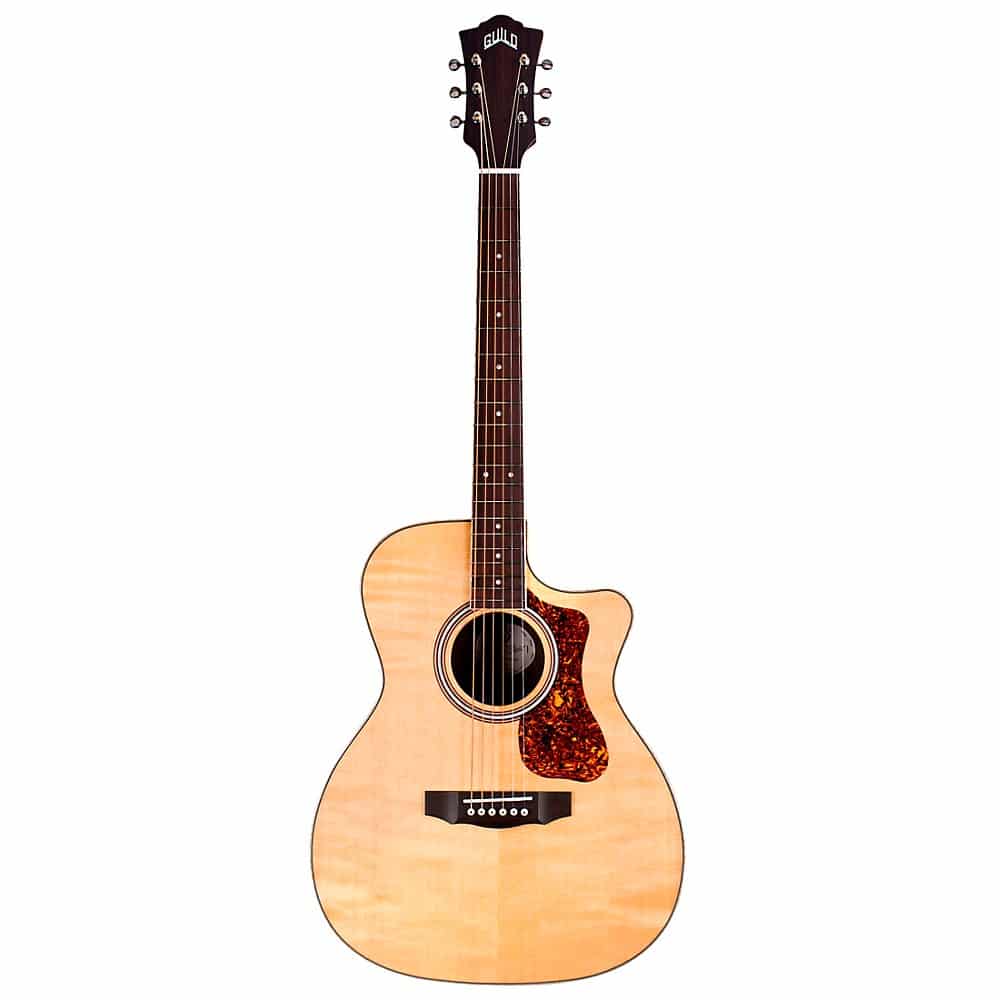I have to say I was excited when AS asked me to review the Guild OM-250CE. I’ve been a Guild fan since I bought my first good acoustic as a kid, a used 1970ish D-35 dreadnaught that got a lot of play over the course of the next decade. My all-time favorite jumbo acoustic (and the best-sounding acoustic I’ve ever owned) is the Guild J65 sitting ten feet away from me, the one that caused multiple people who’d heard it on recordings I’ve done to try to buy it from me. And, yes, I know there’s another company (that starts with a ‘G’) who also makes a maple-backed jumbo acoustic.
The timing was good, too, as I had an upcoming gig that was sure to put any acoustic-electric to the test. I was subbing in on a duo with a great singer (hey, Ernie!). The catch was that I was subbing for a pianist, and while Ernie plays some bass, most of the night would be his voice and my guitar. Since Ernie is kind of a local legend and because I had to cover a lot of ground that night, both amplified tone and playability would be critical.

First Impressions
As a rule, I try to know as little as possible about a reviewed instrument until after I’ve made my notes, but the first couple of chords on the unplugged guitar made me suspect (correctly, as it turned out) that this was a solid spruce top. The acoustic tone was a bit brighter and louder than I expected. Note that the reviewed instrument came fresh out of the box, so the strings had zero wear on them until I picked it up.
The combination of a satin-finished neck but high-gloss top, back and sides was a good choice in my opinion. I’m normally a traditionalist when it comes to guitars, but I’ve come to appreciate the feel of a satin neck (especially outdoors on hot, humid days). However, I still prefer the look of a glossy finish on the body, so this combination worked well for me.
The slightly off-center position of the strap button guitar was designed so the guitar on a strap was perfectly balanced. The guitar also seemed very well-made. The slightly arched rosewood back (an extra step in the build process) was a nice touch and reminiscent of the great Guilds of times past.
The fretwork and flamed maple neck binding was well done, and the latter was my first hint that this was an imported guitar, since flame maple binding has lately appeared on a lot of mid- to high-level imports. Another surprising but increasingly common feature on some imports is the use of decorative pearl, rather than pearloid. This was the case on the reviewed guitar, both on the fingerboard inlays and in the rosette.
Playability
I was easily able to get around all the way up the neck. The reviewed instrument came with a brand new set of what felt like .012’s. Action and accessibility were great, which was good news since the gig on which I used it had me up around the 12th – 15th fret for some parts.
Up on those higher frets, the high ‘E’ string seemed a tad sharp while the ‘A’ sounded a tiny bit flat, but this may have been the result of the guitar having sat for a while since its factory setup, and would be no issue for those who stay below the 7th fret. A quick look at the bridge saddle (which, like the nut, is bone) confirmed that there was enough room on the saddle cuts such that a setup by a skilled luthier would have cleaned up the intonation.
Tones – Acoustic and Electric
On an imaginary “dark to bright” scale of acoustic tone, I’d put the OM-250CE at about an 8. Even for an orchestra-sized model, the acoustic tone was more high-mid heavy than expected, possibly a big plus for those who prefer a more modern and present acoustic tone. I did have the opportunity to hear it acoustically from an audience member’s perspective and thought it would cut through a band mix well, though it might be a bit too present for some acoustic solo performers.
When someone buys an acoustic-electric, it’s a good bet that much of its career will be spent going into sound reinforcement systems. I tried the OM-250CE with my trusty Baggs Para DI into the PA and it took some time to EQ it to the room. I had just a little time to set up an EQ profile but could only find a narrow range between “too present” and “not present enough”, even while attempting some sonic surgery with high-Q filters in the mids. The pickup system is a Fishman Sonitone GT-1, a common OEM choice used where budget is a consideration. I reviewed another imported acoustic-electric earlier this year where the GT-1 was a little easier to quickly dial in a tone.
Fair warning: while A/Bing the OM-250CE against another guitar, I may have been making an unfair comparison because on the night of the gig where I used the OM-250CE I did not yet know its price (MSRP is $870, and it’s available online for a very reasonable $700). The other guitar was not only my own, but cost multiples of what the OM-250CE does.
I’ve said it before, but the quality of reasonably priced, affordable Asian-made instruments continues to amaze me, and the OM-250CE offers a lot of bang for the buck. Always remember, when reading this or any other review, that my ideals may be not be yours. If you get a chance to try this model, I’d say it would be worth your time to take a look.
